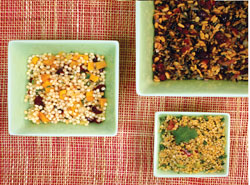Mad for Millet
Bringing Whole Grains Back © Getty Images
© Getty Images
Although things are slowly changing, 42 percent of Americans still eat no whole grains at all—and only seven percent of us get the recommended three servings per day. But when I serve millet or quinoa as a side dish or incorporated into a casserole, my friends quip, "You’re feeding us bird seed again!"
Birds, it seems, know what’s good for them. Most Americans are familiar with millet only as an ingredient in birdseed, but this was one of the earliest cultivated grains. Today, it sustains one third of the world’s population, and is widely used in Asian, African and Eastern European cuisine. Soothing and easily digested, it is one of the least allergenic, non-glutinous grains available.
Another ancient grain, buckwheat, is not a true grain or grass, but a fruit seed related to rhubarb and sorrel. This hardy plant grows well on poor, acidic soils, is tough enough to push out most competitors, and is one of the few commercially grown crops that don’t require chemicals in the field or in the processing plant. Although a rarity in the U.S., buckwheat is common in many parts of the world. French galettes, Japanese soba noodles, Russian bliny and Ukrainian hrechanyky are all made with buckwheat. Kasha, or roasted buckwheat groats, is a common side dish among Eastern Europeans.
While barley is one of the first foods given to babies, most adults have neglected this wholesome grain, with its distinctive nutty flavor and chewy texture. This adaptable, hardy plant grows in soils and climates from the tropics to the Arctic Circle, and has been cultivated for more than 7,000 years in Asia and Africa. Barley’s fiber is found throughout the kernel, not just in the bran, so even heavily pearled (polished) barley contains ample fiber. According to Jackie Keller, founding director of NutriFit, barley has a lower glycemic index than other grains, so it is absorbed slowly into the bloodstream, helping to regulate blood sugar.
Forgotten Grains
Before potatoes and corn migrated from the New World to the Old, barley, buckwheat, rye and millet were the staple foods of northern and central Europe. Though they have largely been replaced by rice and pasta, they can be found in most health food stores and increasingly in specialty sections of larger supermarkets. Each has a unique nutritional profile, so variety ensures a complete nutrient balance. All contain important fiber, vitamins, minerals, protein, and an assortment of phytochemicals.
Dr. Janet Bond Brill, a nutritionist and author of Cholesterol Down, points out, "Diets rich in whole grains are linked to a reduced risk for many of the chronic diseases and health problems that plague our nation, such as cardiovascular disease, obesity and certain types of cancers, high blood pressure and constipation."
So why don’t we eat more grains? For the most part, we don’t know what to do with them. Even with the movement to "whole foods," few Americans eat the pure grain kernels. Instead, we reach for processed grain products. Many "wholegrain" breads, cereals and pastas have a substantial amount of refined flour, sugar and chemicals, because all that is needed to feature the government’s new whole grain stamp is eight grams (half a serving) of whole grain. Researchers at the U.S. Department of Agriculture (USDA)’s Economic Research Service found that most of the whole grain foods consumers ate were crackers, snacks and ready-to-eat cereals—all processed food products.
Using Grains
Many whole grains cook quicker than the ubiquitous rice, and can serve as the foundation for easy, appetizing dishes. A pilau is a one-pot meat-and-vegetable grain dish with many variations. Stir-fries can be served over a variety of grains, and grain salads make for a light, simple meal.
Keller, who in addition to her work at NutriFit is also a nutritionist, certified wellness coach and a Cordon Bleu-trained chef, says there is nothing more satisfying and simple to make than a bowl of vegetable-barley soup. She rinses the barley, puts it in a pot with water, a little sea salt, and her favorite vegetables, and lets it cook. Keller also uses millet in kale stew and veggie burgers.
Grains can replace rice, potatoes or pasta. They can be served under meat or sautéed vegetables; give extra body to soups and stews; and can be incorporated into casseroles, soufflés, or stuffing. They even make a great hot breakfast cereal.
YVONA FAST is the author of the New York food column, "North Country Kitchen," and maintains the site www.wordsaremyworld.com

